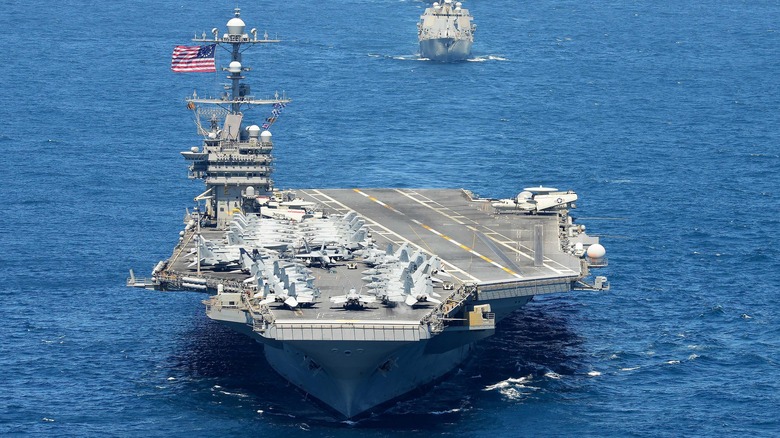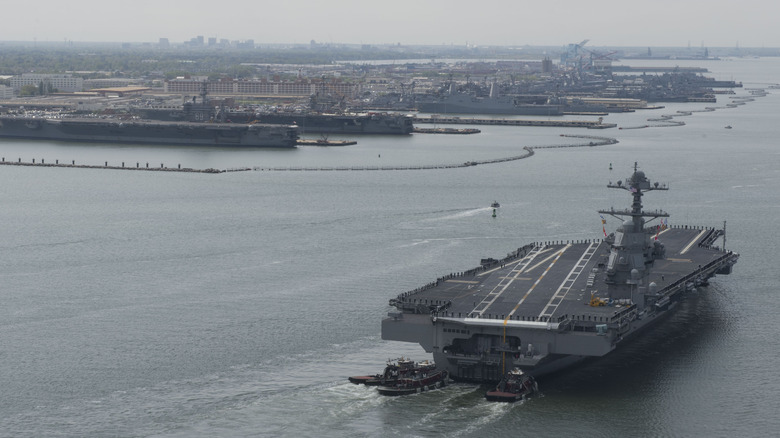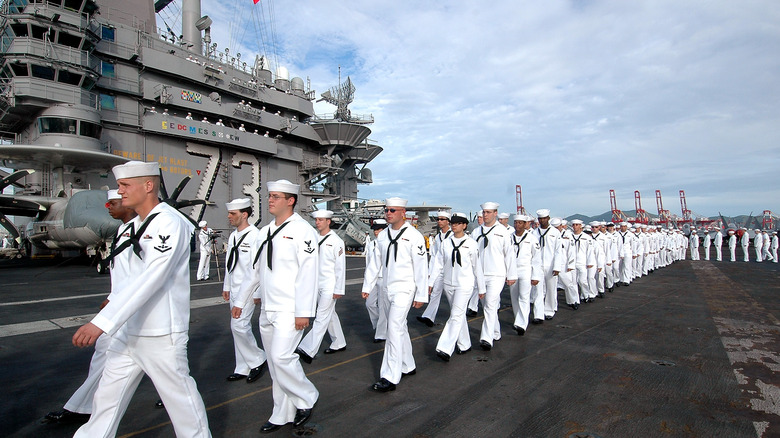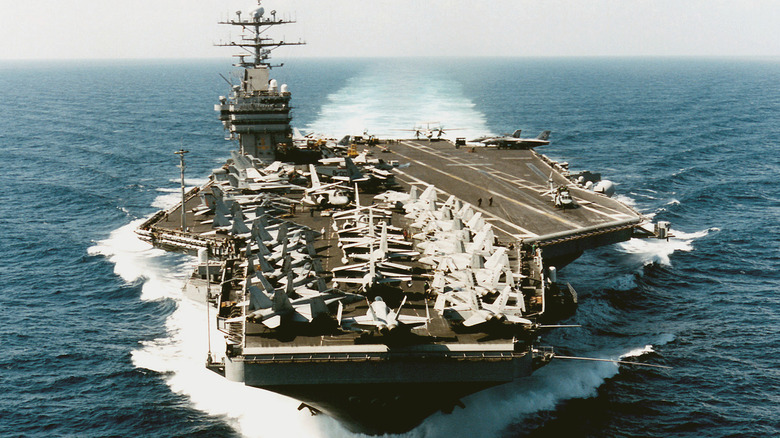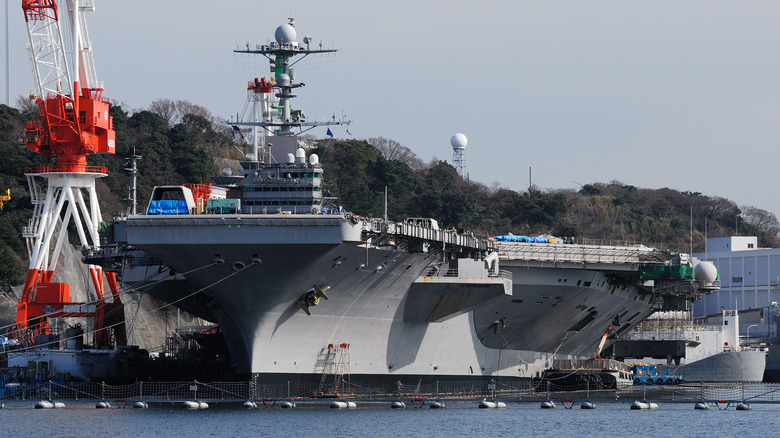How Many People Are On The USS George Washington (CVN 73) & Where's Its Homeport?
The USS George Washington (CVN 73) is the sixth Nimitz-class aircraft carrier to serve in the United States Navy. Continuing the proud tradition, the USS George Washington is the fourth Naval vessel to be named after the Founding Father and first President of the United States. The vessel was christened on July 21, 1990, entered active service in July 1992 with a Nimitz-class carrier's lifespan of 50 years, and continues operations more than 30 years after it was initially launched. Like all of the U.S. aircraft carriers, a lot of people work incredibly hard to ensure it remains fully mission capable.
Nimitz-class aircraft carriers all have the same basic configuration, and they've also undergone Refueling and Complex Overhauls (RCOH) to modernize and continue operations. The ship's complement consists of 3,500 ship personnel and an additional 2,480 for its air wing. That's 5,980 personnel working around the clock to keep the USS George Washington in the fight. Of course, the ship cannot be engaged in constant military operations 24/7, and it has a relatively lovely homeport.
Initially, the USS George Washington (CVN 73) aircraft carrier was based out of Naval Station Norfolk, Virginia, but that changed in April 2024. The Navy ship relocated to Fleet Activities Yokosuka, Japan, replacing the USS Ronald Reagan (CVN 76). The move came after the ship completed its midlife RCOH, bringing it up to modern standards and ensuring the U.S. presence in the South Pacific remains uncontested should things heat up with North Korea or China.
The USS George Washington's RCOH took longer than expected
Nimitz-class aircraft carriers like the USS George Washington receive an RCOH midway through their intended lifespans. The RCOH extends the life of the carrier by refueling its nuclear power plants. It began its RCOH at Newport News Shipbuilding in 2017, which was two years later than initially intended. Budgetary issues and other concerns kept the ship from beginning its RCOH for a couple of years.
It entered into its RCOH late, and it remained in Newport for an additional two years due to a series of problems. The biggest issue related to the quality of life for the crew assigned to the USS George Washington while it underwent its RCOH. There were nine personnel who died by suicide throughout the process, prompting the Navy to undertake an extensive investigation. While this delayed things, it wasn't the only issue.
The impact of the COVID-19 pandemic furthered delays as the virus impacted the workforce and supply chains, making further upgrades difficult and time-consuming. Ultimately, the USS George Washington finished its RCOH after six years.
If you or someone you know is struggling or in crisis, help is available. Call or text 988 or chat 988lifeline.org
The large crew operates a large ship
The USS George Washington has a large crew complement, which isn't unusual for a ship its size. The vessel can accommodate over 6,000 personnel, though it typically operates with fewer on board. The large crew requires quite a lot of food to sustain, amounting to 18,000 meals required each and every day it hosts a full crew. When it was constructed, the USS George Washington was one of the largest aircraft carriers ever built, weighing around 100,000 tons with a length of 1,092 feet.
Despite its massive size, the USS George Washington is relatively fast. The aircraft carrier can speed along the waves at 34.5 mph, making it fast enough to keep pace with the vessels in its Carrier Strike Group. Nimitz-class carriers are nuclear-powered, and the USS George Washington is no exception. The carrier houses two Westinghouse A4W nuclear reactors capable of generating 194 megawatts of power. This translates into more than 260,000 shaft horsepower, which is how it achieves its impressive speed.
Attached to its shafts are four five-bladed propellers of immense size. Each propeller is 22 feet in diameter and weighs 66,220 pounds, and with its fresh supply of fuel, the carrier can transit over 3 million nautical miles of ocean before needing to refuel. The carrier hosts a large air force consisting of up to 90 fixed-wing aircraft and helicopters of different types. Most notably, the Navy vessel carries a variety of advanced fighters, including the F-35C Lightning II and F/A-18F Super Hornets.
The USS George Washington (CVN 73) aircraft carrier is armed to the teeth
When most people think about the armaments of an aircraft carrier like the USS George Washington, they likely consider its aircraft. After all, the USS George Washington's air force is a formidable, forward-reaching combat capability that rivals many nations. While the fighters and helicopters aboard the carrier are certainly formidable, the ship itself houses a variety of weapon systems for offensive and defensive purposes.
The USS George Washington features two to three Mk. 29 launchers capable of firing RIM-7 Sea Sparrow SAM missiles or RIM-162 Evolved Sea Sparrow Missiles (ESSM). It also features a Mk. 49 missile launching system that fires off RIM-116 Rolling Airframe Missiles (RAM). For point defense, the carrier has three to four Mk. 15 Phalanx Close-In Weapon Systems (CIWS), which shoot down incoming missiles and indirect fire weapons.
On top of that, the carrier also boasts numerous Mk. 38 Machine Gun Systems. These weapons are primarily used against small boats that approach the ship. The system consists of a 25-millimeter M242 machine gun capable of hitting targets at a distance of 2,000 yards. In addition to its weapon systems, the carrier is equipped with nearly a dozen radar systems, missile guidance systems, and torpedo decoys. All of these systems work together to ensure the carrier's safety while deployed and engaged in combat operations. The ship's aircraft can also provide immediate offensive and defensive capabilities, but are more suited to strike targets far from the carrier.
The carrier returned to where it made history
As it happens, the USS Ronald Reagan wasn't the first nuclear-powered aircraft carrier the U.S. sent to a homeport in Japan — that honor belongs to the USS George Washington. In 2008, the USS George Washington became the first nuclear-powered carrier to port in Japan at Yokosuka Naval Base. It was also the only nuclear-powered ship the U.S. Navy deployed to Japan at that time, so it was truly a momentous occasion. The moment was historic, as it marked the first time such a vessel was sent by the U.S. to Japan — not to attack, but to defend the nation it bombed with two nuclear weapons in the closing days of World War II.
The USS Ronald Reagan took over for the USS George Washington in 2015 so it could undergo its RCOH. Now, the USS George Washington has returned to Japanese waters, where it made history nearly two decades earlier. The ship will remain in the 7th Fleet area of responsibility (AOR) as the U.S. only forward-deployed naval force (FDNF) carrier in the region. While there, the USS George Washington will maintain the U.S. presence to ensure the peace and safety of the Indo-Pacific region remains sacrosanct.
